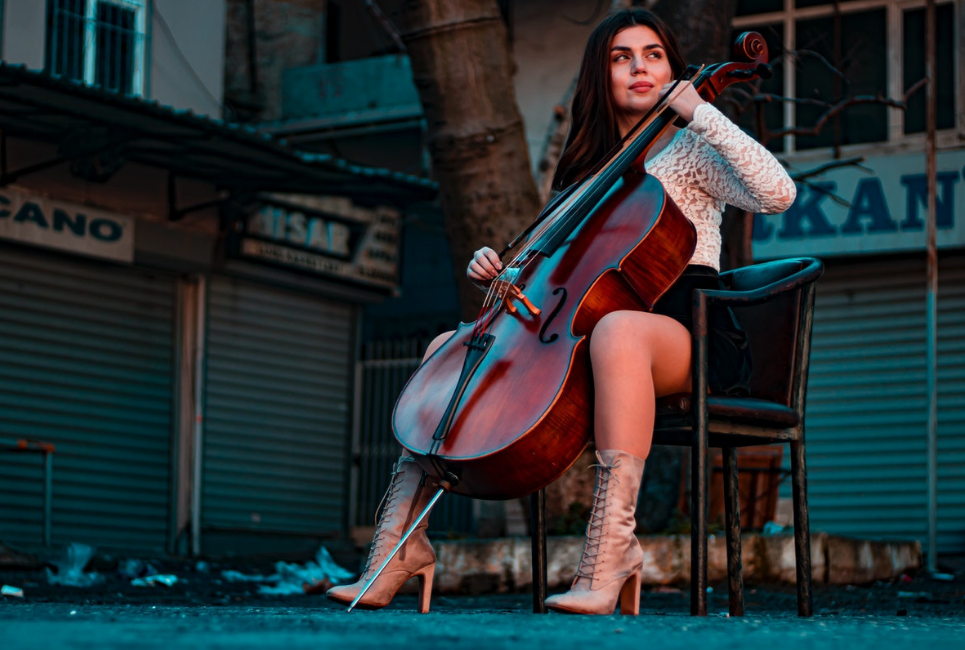- Best Carbon Fiber Cello Options - December 28, 2021
- How to Find the Best Electric Cello: Why I Love The Bridge Draco - December 16, 2021
- How to Find the Best Jazz Cello: Jazz Cello’s I Recommend - December 13, 2021
When you buy an item using one of our links, we may earn a portion of the sale. Strings Guide and some products featured on the site are owned by the same company. Learn More.
If you’ve struggled to be heard onstage, you may have considered an electric cello. With an electric cello and amplifier, you’ll have no problem reaching Eddie Van Halen levels of volume. While they are still uncommon, electric cellos can be found today on stages, soundtracks and recordings. But how do you find your perfect electric cello?
If your search has left you feeling overwhelmed, never fear! We’ve compiled a list of the best electric cellos. Whatever your playing skill and whatever your reason for wanting an electric cello, we have an instrument that’s just right for you! Read on for more.
How I Chose the Best Electric Cellos
When looking at the different electric cellos on the market, here are a few things I considered:
Ability Level
If you’re a novice cellist, or if you just want to try an electric cello out, you need a solid and reasonably priced student instrument that will help you master the basics. You need an instrument that is comfortable to play through hours of practice, and one where you can tell the difference between a good and bad take.
If you are a serious electric cello player, you may want a more advanced instrument. You’re willing to invest more money in your new instrument because you’ve already invested the time. Professional musicians have different needs than amateurs and can benefit from a higher-quality electric cello.
Price
Electric cellos are generally less expensive than their acoustic counterparts because they are easier to build and have fewer fragile and labor-intensive parts. But a cheap electric cello with a faulty pickup, or one that won’t stay in tune, is no bargain at all. You can find less expensive generic models online, but you get what you pay for.
The electric cellos on this list range from around $400 to over $4,000. In a world where you can spend millions for an antique cello, those prices are positively reasonable.
Use of Electric Cello
There are many reasons why you might want an electric cello, such as:
- An electric cello allows you to plug in headphones and rehearse even the most energetic passages quietly.
- Electric cellos are less prone to weather damage, making them a good choice for outdoor events.
- Electric cellos can be less bulky than acoustic cellos, making them good for people in small spaces.
- Electric cellos can be plugged into DAWs for signal manipulation and effects, and for ease of recording
Flexibility
Working musicians are often called to play different musical genres. An electric cello which can be used in many different settings scores points over an instrument that is only suited to more specialized situations. Music may warm the soul and stir the heart, but it’s not so good at fattening the wallet. If you invest in an instrument, you want to use it at as many gigs as possible.
Top Pick: Bridge Draco
The Bridge Draco combines style and engineering in a package that looks as beautiful as it sounds. Many professional musicians, including genre-straddling performer Cello Femme (Fani Villarón) and neoclassical composer and cellist Simon McCorrey, rely on the Bridge Draco for performances and recordings. Every instrument on our list has its merits, but the Bridge Draco wins our all-around award for the best electric cello.
Here’s a video of Cello Femme playing a Bridge Draco:
Best Electric Cello for Beginners: Cecilio CECO
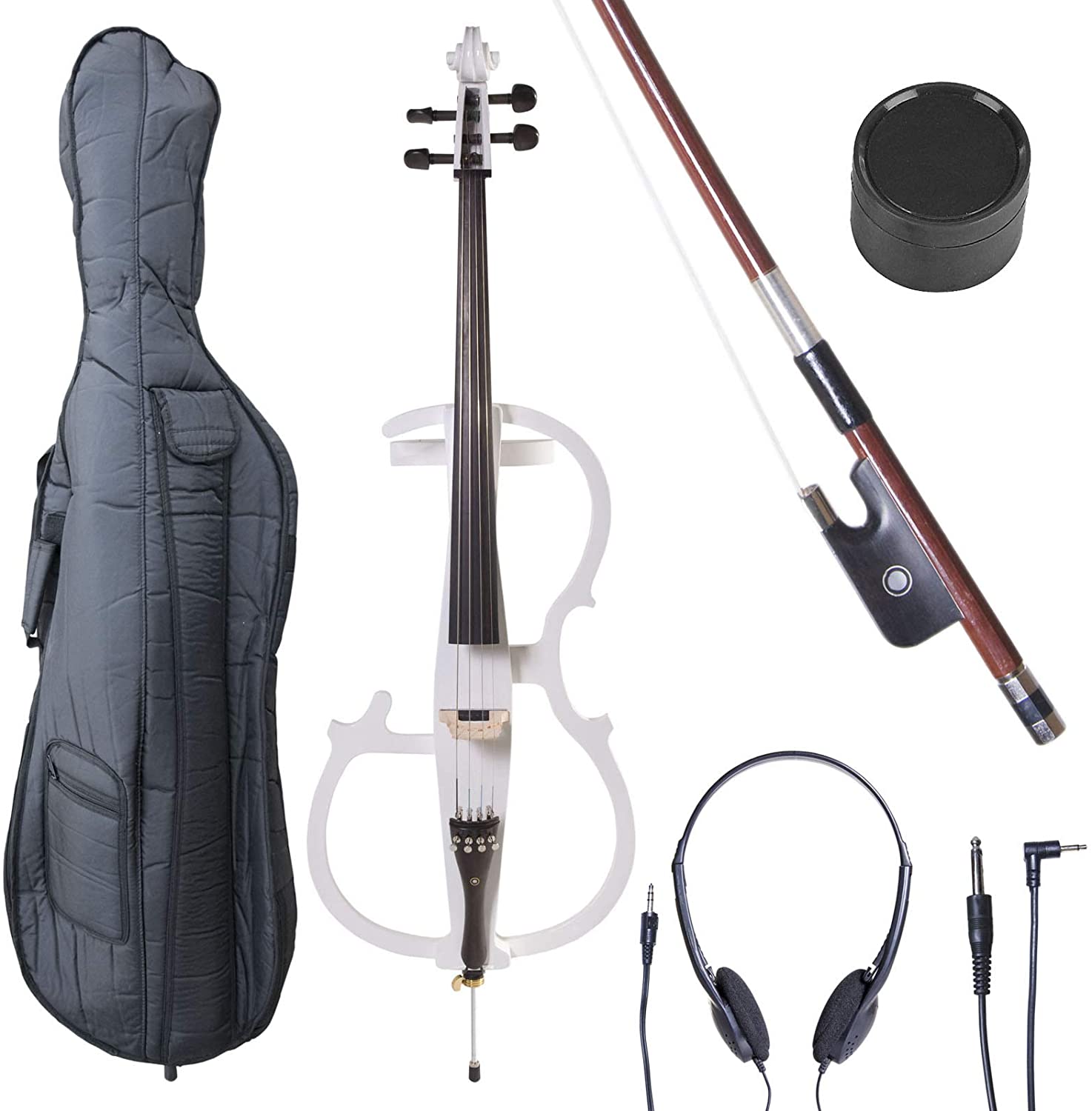
An electric cello differs from a regular cello as much as an electric guitar differs from an acoustic guitar. If you are adding an electric cello to your collection, you can expect a learning curve as you master its capabilities and quirks. The Cecilio CECO is an inexpensive introduction to the art of electric cello for curious beginners.
Chinese luthier Cecilio has become a household name among student musicians for their well-made but inexpensive instruments. The CECO comes in 1/8, 1/4, 1/2, 3/4, and full sizes so even very young cellists can play. And the CECO comes with rosin, a bow, an auxiliary cable, a soft case, and headphones you can use for quiet rehearsals. The CECO even arrives with its 9-volt battery installed!
A ebony fingerboard and mother of pearl inlays are not often found at Cecilio’s very reasonable price point. Many amateur musicians will find the CECO has everything they need in an electric cello.
Pro
- Inexpensive
- Comes with everything you need to start playing
- Has features typically associated with more expensive instruments
Cons
- Serious electric cellists will probably graduate to a better instrument
Best Intermediate Electric Cello: NS Design WAV4c Electric Cello
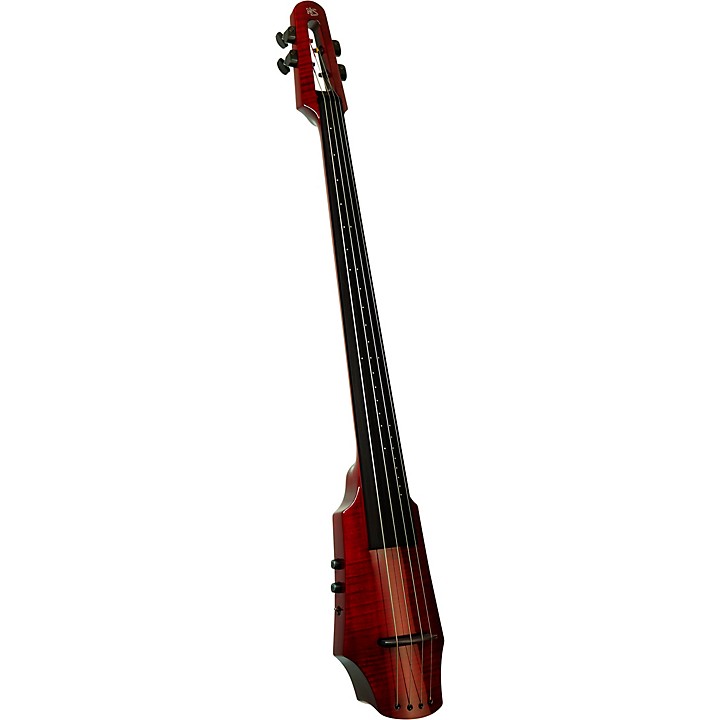
If you’re a serious cellist looking for an electric cello as a second instrument, NS Design’s WAV4c is for you! The NS Design’s solid body means you never need worry about wolf tones when playing, and NS Design’s patented Polar Pickup system gives you a surprisingly deep and rich sound that belies the WAV4c’s unassuming looks.
At only 4.5 lbs. (2kg), the WAV4c is easy to carry, though you will also need to bring an amplifier. The WAV4c has volume and tone controls, and allows you to switch between a horizontal pickup for bowing and the vertical pickup for pizzicato. And if four strings aren’t enough for you, NS Design’s WAV5c adds a fifth low F string (with a high E 5-string setup available on request for those wishing to electrify Baroque music.
NS Design is the brainchild of instrument maker Ned Steinberger, and is especially famous for its electric basses. The WAV4c is a great touring companion and could easily help you become the Godfather of Heavy Metal Electric Cello. And with the optional Frame Straps or Boomerang Straps, you can even stroll around on stage while playing!
Pros
- Light, durable and easy to transport
- NS Frame Straps and Boomerang Straps let you play while standing and walking
- Designed by a company that specializes in electric string instruments
Cons
- Not the most attractive electric cello on the list
Best Electric Cello for Rehearsals: Yamaha SVC-50SK Silent Compact Cello
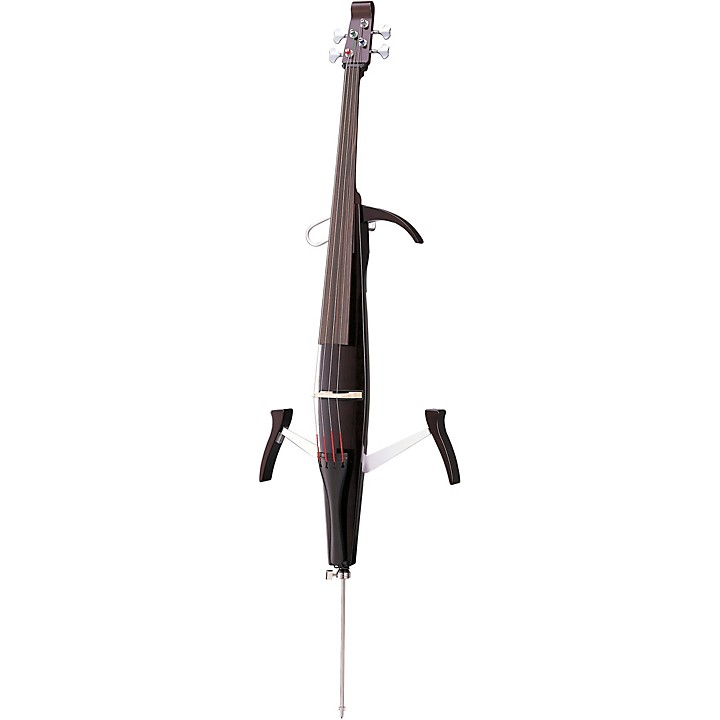
Cellos are great instruments, but they are also bulky and fragile. If you want to stay in practice but don’t have space for a cello in your dorm room or summer home, the Yamaha SVC-50SK can help you keep up with your lessons.
The SVC-50SK is designed for people in cramped spaces. The leg rests make it more comfortable when you play, but can easily be removed for easy storage. And where an acoustic cello might take up your whole closet, you can easily slide the SVC-50SK under your bed.
Along with the headphone jack, the SVC-50K also includes an auxiliary input. You can plug in a CD player or digital music source and listen on your headphones as you play along to the accompaniment. You can use the headphone jack as a line out to an amplifier for performances. The SVC-50SK is not just a rehearsal tool, it is a serious instrument in its own right.
Pros:
- Breaks down for easy storage
- Auxiliary input lets you play over backing tracks
- Excellent quality control and customer service
Cons:
- Does not come with bow or rosin
Best Electric Cello for Performers: Bridge Draco
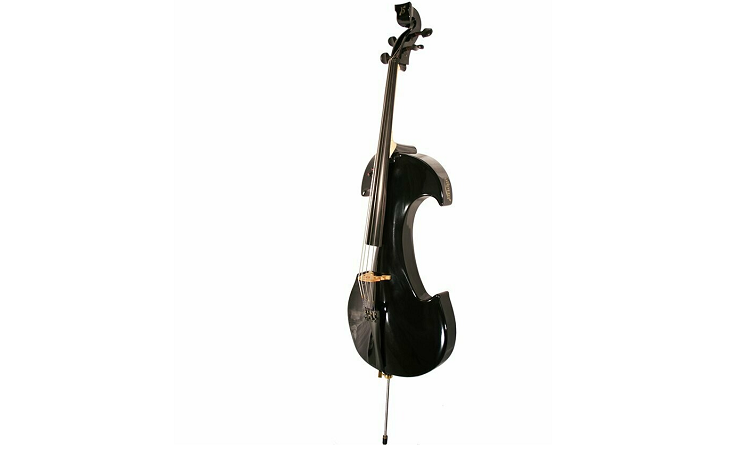
While many electric cellos use utilitarian but not especially attractive designs, the Bridge Draco‘s bright colors and sweeping curves make it look like a work of modern art. No matter the genre, you’ll be the center of attention onstage when you play your Draco. And the Draco’s hollow carbon fiber/Kevlar composite body isn’t just beautiful, it adds a rich resonance to the sound that you won’t get with more bare-bones electric cello designs.
The Draco plays very much like an acoustic cello, with a richly varied and responsive bow response. Bridge’s proprietary piezoelectric pickup has great dynamic range that will keep the softest passages clear yet rise to the occasion for those moments when you soar toward triple fortissimos. And the Draco’s volume and tone controls help you dial in exactly the sound you want.
If you are a serious musician who uses an electric cello in performance, the Bridge Draco will be a fantastic investment in your career.
Pros
- The most eye-catching electric cello on the market
- An excellent choice for jazz, rock, pop, house, and neoclassical performers
- Hollow body gives the Draco better sound than many electric cellos
Cons
- Will stand out on stage, but may stick out like a sore thumb in a conventional string quartet.
Best Acoustic Cello with Built-In Electric Pickup: Eastman Albert Nebel 601+
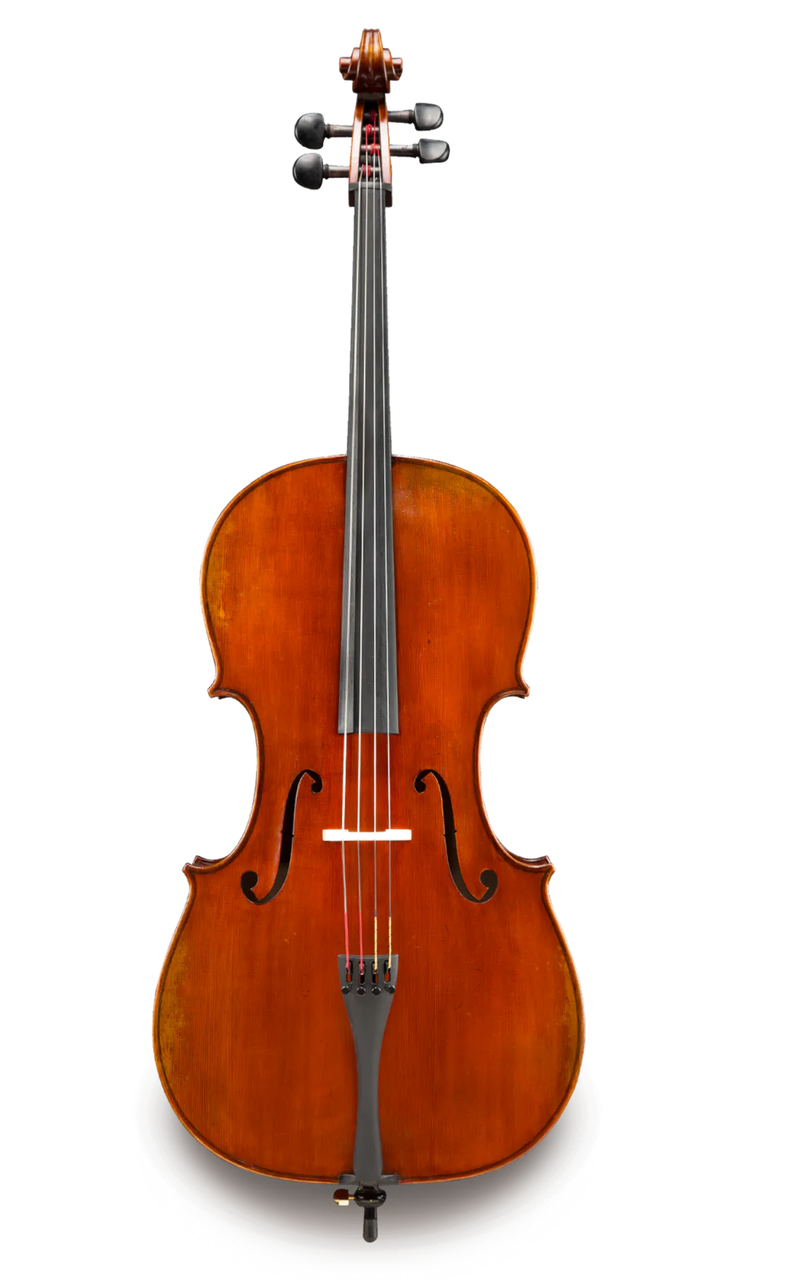
You like the electric cello’s potential but you also play a lot of acoustic gigs. Eastman’s 601+ cello gives you the best of both worlds. Eastman’s Albert Nebel 601 cello is beloved by performers for its warm, rich tones and great projection. Before the top is varnished, Eastman adds a pickup on certain select 601s that become the 601+.
Near the endpin the 601+ has a 3.5mm (1/8″) jack that lets you plug into an amplifier, controller, or DAW. If you’re playing in a small room with a string quartet, you can leave your 601+ unplugged and no one will know your electric secret. The 601+’s aged spruce top and aged German maple sides provide all the complexity and resonance you expect from a professional-quality cello.
The 601+ doesn’t allow for quiet rehearsals with headphones, and it lacks the volume and tone controls you find on many exclusively electric cellos. But its sound is gorgeous with or without amplification, and the 601+ is the most versatile cello on our list.
Pros
- Professional-quality rich tone and responsiveness
- Suitable for both amplified and acoustic performances
- Aged wood gives the 601+ a beautiful vintage sound
Cons
- Lacks some of the features of other electric cellos on our list
Frequently Asked Questions (FAQ)
Answer: While you can easily spend tens of thousands of dollars on a high-end professional acoustic cello, electric cellos can be had for surprisingly reasonable prices. Electric cellos do not require the labor-intensive resonant bodies of an acoustic cello. A Bridge Draco, one of the most highly-regarded electric cellos on the market, costs under $3,000 and the Cecilio CECO costs around $400 for a complete outfit.
Answer: While you can use an electric cello for rehearsals and performance, most cello teachers recommend beginners start with an acoustic cello. Projection and dynamics are an important part of playing cello, and learning those bowing skills on an acoustic cello will improve your performance when you play an electric.
Answer: You can plug headphones into your electric cello’s line-out jack and rehearse very quietly. Most electric cellos lack resonant chambers that amplify the strings like an acoustic cello’s body. But the rubbing of the bow against strings will still produce some sound. You should be able to rehearse behind a closed door without being heard, but people in the room with you might find hours of quiet scales annoying.
Final Words: What Is the Best Electric Cello?
For serious musicians and performers, the Bridge Draco is the best electric cello on the market. Its sweet sound and sexy style is sure to win you fans. The Draco’s hollow body gives its sound an extra depth and complexity many electric cellos lack.
If you are just getting started, the Cecilio CECO is the best electric cello for beginners and casual musicians. The Cecilio will provide you with a solid introduction to what the electric cello can do – and, if you already play acoustic cello, things that an electric cello can’t do!
If classical gigs make up the lion’s share of your work, the Eastman Albert Nebel 601+ is the best electric cello for classical musicians. You can play the 601+ unamplified in chamber and orchestral settings, then plug in whenever necessary thanks to its built-in pickup.
The best electric cello is the one that lets you play your best. Best of luck in finding your perfect electric cello, and happy playing!
Looking for more interesting readings? Check out:

